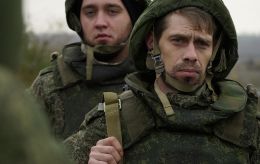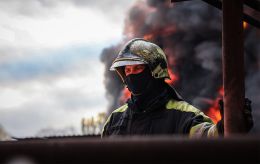Russia launches counteroffensive? What's happening in Kursk region
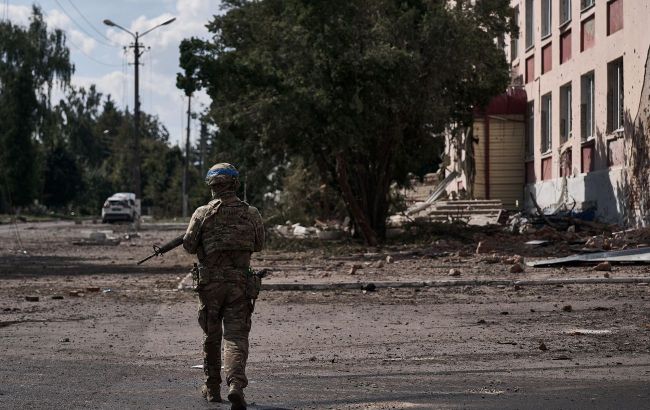 Photo: Ukrainian soldier in Kursk region (Getty Images)
Photo: Ukrainian soldier in Kursk region (Getty Images)
A month after the Ukrainian Defense Forces began operations in the Kursk region, the Russian army is likely launching a counteroffensive. This is reported by Z-social networks (Russian pro-war pages - ed.) and Ukrainian analysts, though there is no official information from either side.
RBC-Ukraine has gathered everything known at this time.
Contents
- Local counterattacks: Russian side's version
- Offensive from four directions: What Ukrainian publics and analysts are saying
- Will the Russian forces have enough strength to push the Ukrainian Armed Forces out of the Kursk region
Local counterattacks: Russian side's version
The initial source of information about Russia's first offensive in the Kursk region came from Russian pro-war pages. Recently, the Telegram channel Rybar, close to the Russian Ministry of Defense, reported that after stabilizing the front, local counterattacks began in several areas. One such area is south of the village of Korenevo, where Ukrainian forces were reportedly pushed out of the forests.
According to other sources, on September 10, Russian forces regained control of the villages of Gordeevka, Vnezapnoe, Viktorovka, and Byakhovo. The offensive is reportedly coming from the Glushkovo district.
Other reports suggest that Ukrainian forces have been partially driven out of the villages of Apanasovka and Snagost. Additionally, one group is said to have been encircled in the village of Krasnooktyabrskoye, which was blocking the land route for the Russian army to territories south of the Seim River.
On the night of September 11, videos of the assault on Snagost began appearing on social media. One video shows a column of about a dozen armored vehicles approaching from Korenevo. It is reported that the column entered and allegedly established itself in the village.
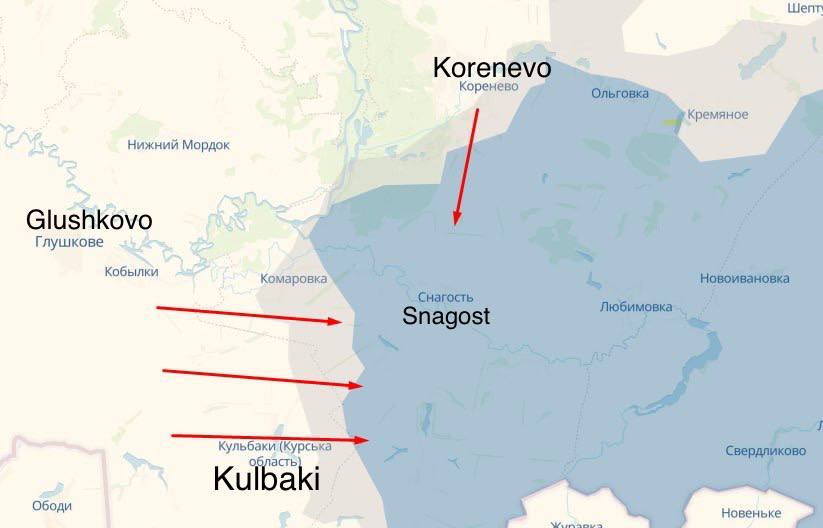
Photo: map of the likely Russian counteroffensive
In the morning, another Telegram channel, Dva Mayora, reported that the Russian army had advanced near Gordeevka, Vneznapnoe, Byakhovo, Snagost, Apanasovka, and engaged in battles for Viktorovka. However, photos and videos of the reportedly occupied settlements have not yet been published. Despite this, there are claims of rapid advancement to the east and control over up to 150 square kilometers.
If the information about the loss of Ukrainian control over Snagost is confirmed, it would mean that Russian troops have managed to unblock a large group encircled in the neighboring Glushkovo district between the border and the Seim River, according to the BBC.
The Russian Ministry of Defense has not announced the offensive. Meanwhile, Apti Alaudinov, the commander of the Akhmat unit, told the media about "clearing around ten settlements." He did not specify which ones. There is currently no evidence to support his claims, as is the case with many others.
Offensive from four directions: What Ukrainian publics and analysts are saying
Closer to midnight, comments from Ukrainian analysts emerged. One of the most authoritative projects, DeepState, reported a worsening situation on the left flank of the grouping in the Kursk region.
According to their data, the Russian forces have initiated active assault operations, first by crossing the Seim River with armored vehicles and then smaller rivers. Another attack occurred from the recently lost Korenevo towards Snagost. Despite constant strikes on pontoon crossings, the enemy has managed to transport equipment and is now attempting to unblock land logistics routes.
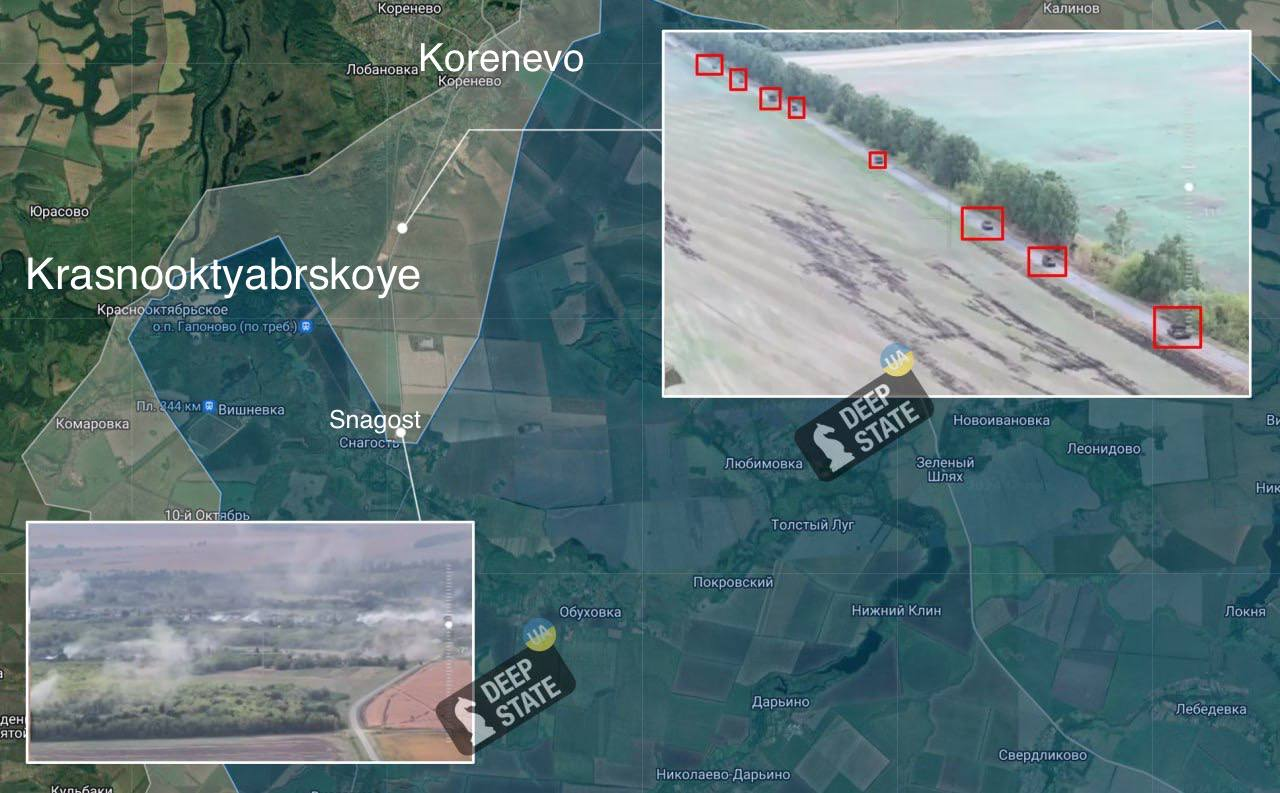
Photo: footage of a Russian assault column (t.me/DeepStateUA)
Hovoryat Sniper (Sniper speaks)Telegram channel run by a Ukrainian military personnel, reports that the enemy is advancing from multiple directions. Active operations are ongoing, and no one has fled, although "some adjustments had to be made." According to their data, by the afternoon, a large amount of enemy equipment and personnel had been destroyed.
Another channel, Ofitser (Officer), emphasizes that the enemy has shifted from using cluster munitions to mechanized assaults with armored vehicles. The situation has changed: the enemy has managed to accumulate and deploy resources for the offensive. "... they are assaulting in small groups; we have currently lost a company, 3 BMPs, a tank, and an APC. We're fighting hard. We’ve managed to slow down their advance a bit," it quotes one of the participants in the battles in the Kursk region.
Military-political analyst Oleksandr Kovalenko from the Information Resistance group says that the enemy's actions can be considered a counteroffensive. Having assembled a force of 35,000, the command believes this number is sufficient to push the Defense Forces back.
He outlines that the Russians are attacking from four directions:
- Apanasovka-Snagost: To unblock the Glushkovo district and regain control of the Korenevo-Troitskoye road.
- Zhuravli-Kalinov: To regain control of the Korenevo-Safonovka logistics route and simplify logistics on the northern front.
- Pogrebki: To reach the Lgov-Sudzha road and Sudzha itself from the north.
- Borki: To close the southeastern sector controlled by the Defense Forces along the Psel River.
The counteroffensive involves units from the "twice-eliminated" 155th Marine Brigade, the 56th Air Assault Regiment, the 810th Marine Brigade (engaged in Krynky and near Pokrovsk), the 11th Assault Brigade, and several other military formations.
"In general, the Russian occupying forces currently have a quantitative advantage in the Kursk region, but this has always been the case… The next day will show what this counteroffensive might ultimately lead to," he wrote on Telegram.
As of the evening, Ukrainian officials have not yet commented on the situation.
Will the Russian forces have enough strength to push the Ukrainian Armed Forces out of the Kursk region
Military expert Mykhailo Zhyrohov points out that there is no reliable information about recent events in the Kursk region.
"The situation is such that the information silence at the beginning of the Kursk operation is now working against us. This information vacuum is being filled by Russian channels. Some photos and videos can be tied to the situation," he said in comments on the RBC-Ukraine YouTube channel.
It is clear that the Russian forces have gone on the offensive. According to him, they have concentrated some of their most prepared forces.
"But I can't say anything about the situation because the available information is unofficial. Nothing is officially confirmed," the expert said.
In any case, such actions were expected. According to Zhyrohov, the enemy has enough strength and resources for at least a local operation. How it will develop depends on what the Ukrainian forces will do.
When asked about the chances of the Russians pushing the Defense Forces out of the Kursk region, he said there are possibilities under certain conditions.
"Because we don't have specific fortifications there. Plus, we don't know what the goal of the operation was and what it is now. Perhaps this was the plan all along: enter, support, and withdraw. There may be other options later. Maybe the order is to hold; we don't know. Only a few people in this country know the goal of the operation," he added.
Earlier, Oleksandr Musiienko, head of the Center for Military-Legal Studies, mentioned in an interview with the news agency that the Russians might attempt a counterattack, which could be a "desired scenario" for the Ukrainian Armed Forces, as it would initiate a phase of pinning down enemy units.
Former spokesperson for the General Staff of the Ukrainian Armed Forces Vladyslav Seleznov emphasized that the Ukrainian army entered the Kursk region not to maintain constant control over it. In his opinion, a maneuvering defense is likely to begin, where the Russians will suffer even greater losses when attacking the prepared positions of Ukrainian troops.
For more details, read the material Vulnerable spot: How Kursk operation affected frontline and risks for Ukrainian army.
Sources: information from Russian pro-war media, Ukrainian Telegram channels, the analytical project DeepState, a post by military-political analyst Oleksandr Kovalenko from the Information Resistance group, and comments by expert Mykhailo Zhyrohov on the RBC-Ukraine YouTube project.
